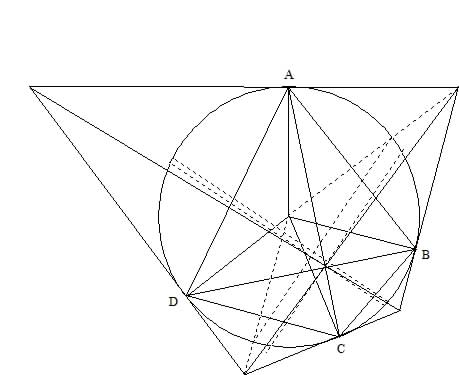Cyclic Quadrilaterals
A quadrilateral with angles ABCD and sides abcd, named in cyclic order, has a circumcircle if and only if A+C = B+D and has an incircle if and only if a+c = b+d. The first of these conditions (since A+B+C+D = 360°) implies A+C = B+D = 180°. [Euclid III.22]
The lines joining the midpoints of opposite arcs are at right angles. These lines are parallel to the bisectors of the angles formed by the diagonals. [Do diagonals of circumscribed quadrilateral cross at same point as the diagonals of inscribed quadrilateral? and are they at right angles?]
The product of the diagonals equals the sum of the products of the pairs of opposite sides: that is AC.BD = AB.DC + AD.BC. (Proof: Take Y on BD so that angle BAY = angle CAD. Then triangles BAC and YAD are similar and AB.CD = AC.BY. Adding these and since BY+YD = BD we get the result.???) [Ptolemy's theorem]

If ABCD are four points on a circle and AC and BD meet at Q, then AQ.QC = BQ.QD. Conversely if this is true the four points lie on a circle. QA.QC is equal to QL² where L is one end of the chord through Q perpendicular to OQ. If ABCD are on a circle and AD and BC meet at P outside the circle, then AP.DP = BP.CP. Conversely if this is true the four points lie on a circle. The value PA.PD is equal to PT² where PT is one of the tangents from P. [Euclid III 35-37]